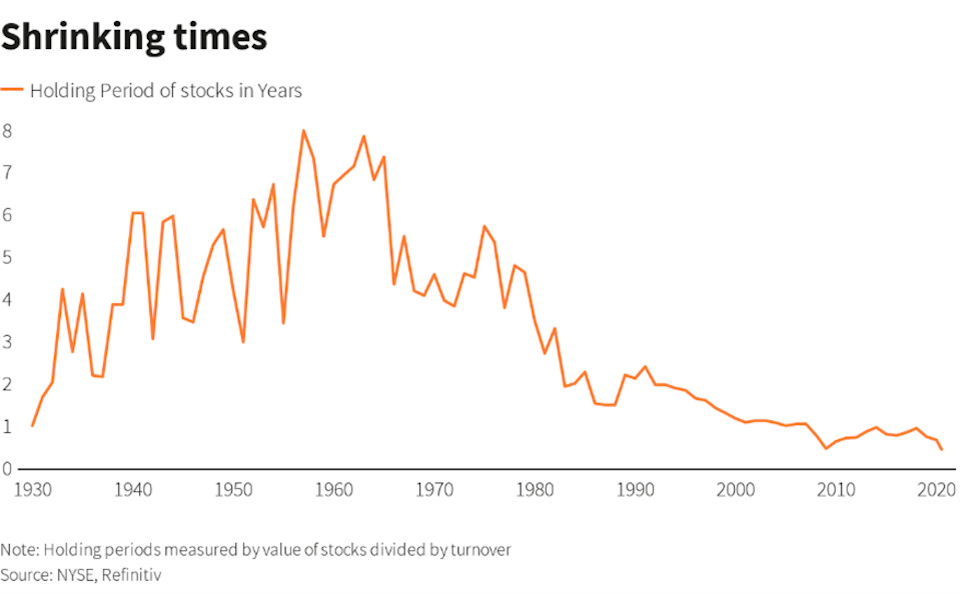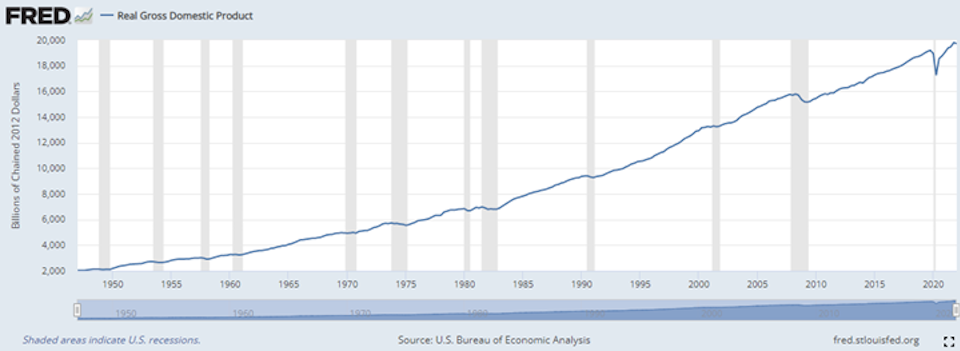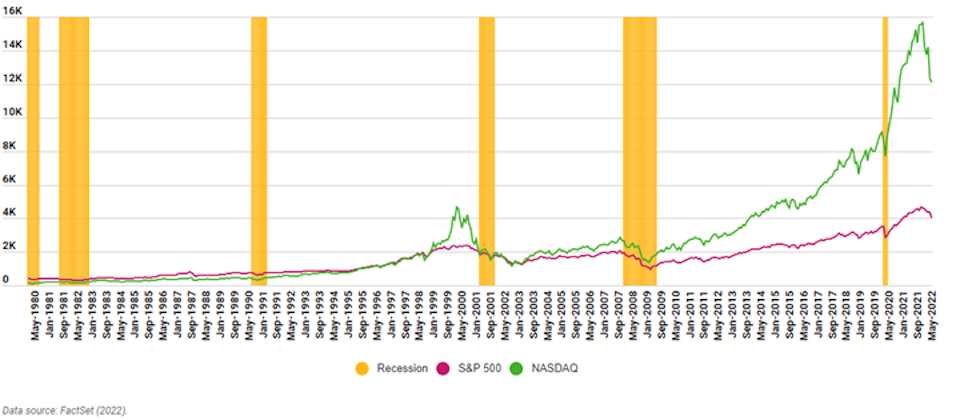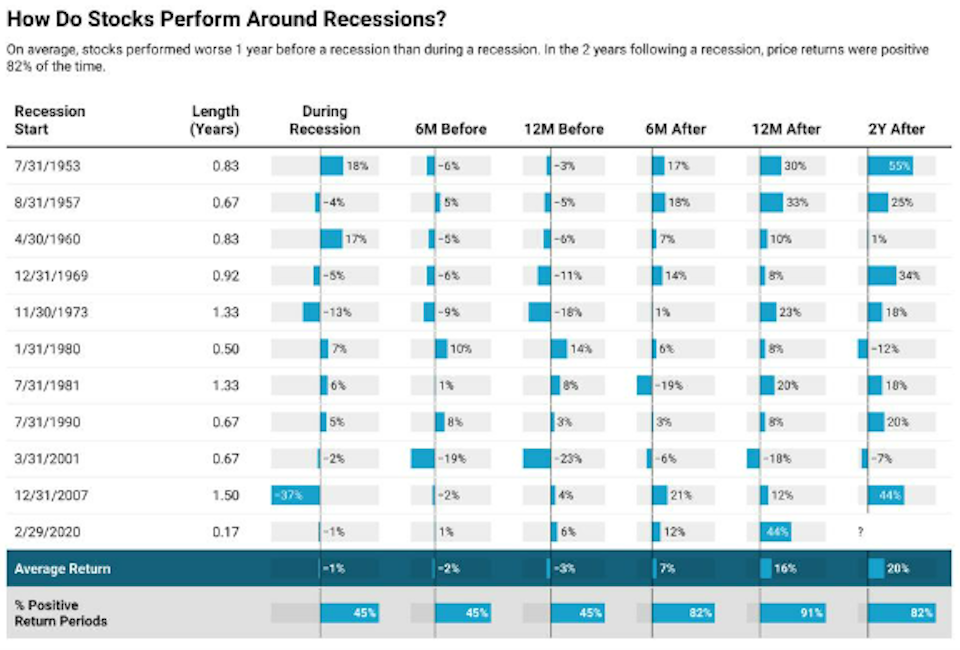(770) 344-0172
(770) 344-0172
Aug 03, 2022

Introduction
It seems you can’t go more than a few days without hearing about American’s shrinking attention span, if you can even focus for that long. This is largely credited to the predominance of cell phones and social media in our everyday lives. Seeing many examples of this across many parts of life got me thinking, does this compression of patience apply to the economy and financial markets as well? This is especially applicable today given that the U.S. economy just posted back-to-back quarters of negative real GDP growth, and the stock market entered bear market territory earlier this year.
These are different questions to answer. As people always say, the stock market is not the economy. Just looking at the most basic measures, this dichotomy is easy to see. In figure 1 (below), the average amount of time that an individual holds a stock for has consistently shrunk since the late 1970s. However, when it comes to recessions, and the bear markets that come with them, there is no trend in their duration as seen in figure 2.
According to a 2020 Microsoft study, the average attention span has fallen by 25% since 2005 to just 8 seconds. For reference, the average attention span of a goldfish has been measured at 9 seconds. This shift has corresponded to a 38% increase in impatience according to the American Psychological Association over a similar time span. Behavioral finance is a field of study that has increased in popularity over the past decade and a half since the Financial Crisis. According to Investopedia, behavioral finance is “the study focused on how psychological influences can affect market outcomes.” Answering the question proposed in the first paragraph will be a test of the extent that behavioral changes can affect markets.
Recessions
Since 1850, the average length of the 33 recessions the U.S. economy has experienced was 17 months. The range of recessions goes from 43 months during the Great Depression (which was followed quickly after by another depression, which are often grouped together in history) to 2 months during the COVID-19 driven recession. The most recent recession was the shortest for numerous unique reasons, but one of them was likely the impatience of people toward lockdowns. While people theoretically have control over one of the major components of GDP, the individual is such a minuscule part, and people don’t think that way. Hypothetically, every person could group together to spend and pull the economy out of a recession, but this is not close to realistic as it would not be in individuals’ best self-interest to accelerate spending when they have lost their job.
However, there is one entity that does have considerable control over GDP: the United States government. It is a monolith entity, but one that is controlled by a small group of people subject to the same trends as the rest of the population. In response to the Great Recession caused by financial engineering, the government has taken the role of propping up the economy by keeping interest rates low and printing money to stimulate investment in the economy. This intervention into natural market forces resulted in the longest bull run of the modern era. Based on this success (the bull run was only stopped by the pandemic), it is reasonable to think that government officials, both in the Fed and among elected officials, believe that they can solve the economic problems again. This is reflected in the amount of spending the government has done in response to economic crises. During the Great Depression, the government spent $800 billion in today’s dollars to stimulate the economy, marking a shift in the role of government in modern society. The government spent $1.8 trillion in today’s dollars during the Great Recession. During the pandemic recession, despite only lasting two months, the government spent a whopping $2.5 trillion (in other news, hello inflation).
The metaphor of forest fires is often used for recessions. During both natural and controlled forest fires, low growth underbrush, debris, and pests are destroyed, allowing more sunlight, better nutrients, and more space to create an even stronger ecosystem. Recessions act in a similar way. They clear out the low hanging fruit allowing what remains to grow even stronger. Now, in our rapid news cycle, government officials do not have the patience to let fires naturally burn. Instead, they are projecting artificial sunlight and planting the nutrients themselves. This will allow for faster regrowth of the forest, but possibly not as robust.
While the above would indicate that the duration of recessions would shorten, I see three factors offsetting this.
Therefore, I think that over the next 100 years, we will see a small decrease in the length of the average recession. But, that trend will have essentially 0 predictive power for the next individual one because recessions are caused by idiosyncratic reasons.
Financial Markets
The financial markets include the stock, fixed income, commodity, and currency markets, but this section will only focus on the stock market, which may make this whole analysis moot as these markets are closely intertwined. Historically, the stock market has been a leading indicator of a recession (like right now, most likely). However, as can be seen in figure 3, the S&P usually does not recover to previous prices until after the recession ends. This was even true during the COVID recession when the S&P did not reach its previous levels until 3 months after the recession officially ended according to the National Bureau of Economic Research. In fact, since 2000, it has taken 647 trading days, or 2.58 years/31 months, for the stock market to recover (this is obviously affected by the fact that the second worst crisis of the last 120 years is one of these, but the Dot.com recession also had a similar recovery time). That means that the average recovery time is 82% longer than the average recession.
You are probably thinking, “that’s terrifying, but measuring the full recovery ignores the fact that there is a bottom, from which you can make significant gains.” And you would be correct. But historically, the bottom almost always comes past the halfway point of the total recession, usually around the three-fourths mark. Of course, past performance does not indicate future results in finance, but this has been a pretty consistent trend that one would need a clear reason to bet against. Since 1953, the market only loses -1% during the actual recession and experiences higher than normal gains afterwards (see figure 4). There is a reason the phrase “recessions make millionaires” exists.
In recent years, the “buy the dip” mentality has entered the investing lexicon. This is the best embodiment of the decrease in patience in the stock market. Will this drive a change in how the stock market recovers from a recession? Most likely not. The “buy the dippers” are retail investors, and largely younger, poorer ones at that, and possess an insignificant amount of capital to make a difference. However, the people controlling institutional money make decisions that are large enough in magnitude to make a difference. While these people are paid to not let their biases influence them, they are human and inevitably will. The average holding period chart on the first page affirms this. Not only has the holding time been steadily falling since 1980, but it has also reaccelerated since 2015 and again fell at an even higher rate in 2021. In practice, this means that managers are moving on from their investments quicker and reallocating to something else; on average, gone is the day of a manager coming up with an idea and continually investing in it for a few years until it works. More churn could lead to a quicker recovery as buyers enter the market quicker. Therefore, under the doctrine of behavioral finance, I see it as plausible that the length of bear markets could decrease (more so than I see that opportunity for recessions) going forward. However, as with recessions, each financial market is unique and these thoughts cannot be guaranteed to be correct about any single event, including the next one.

Figure 1

Figure 2

Figure 3

Figure 4
At Narwhal Capital Management, you’re more than just a portfolio, and it’s not all about the numbers. Let’s start with a meeting about your needs and future goals.